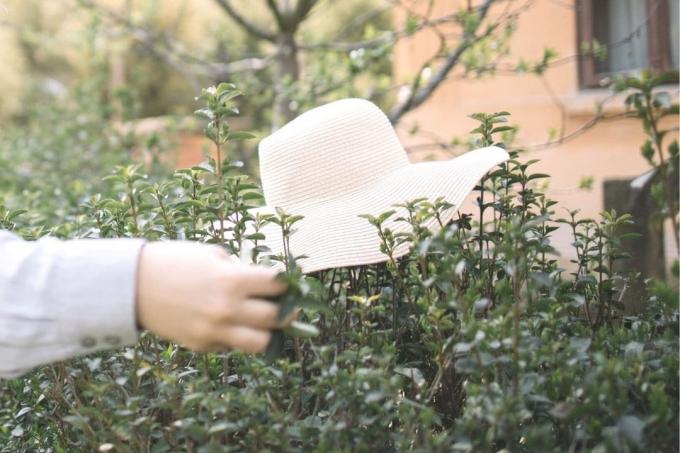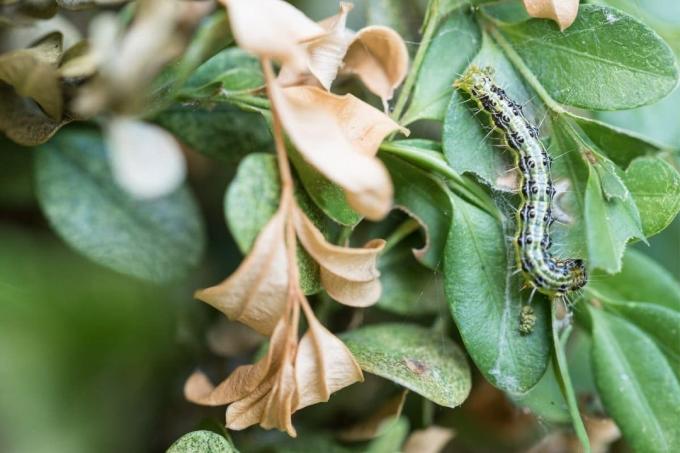
table of contents
- Recognize infestation in good time
- Orientate to the rhythm of life
- When should I inject?
- frequently asked Questions
He already has some splendid box hedges on his conscience, the box tree moth. Various sprays can be used to combat it. But when is the right time to spray against the moth?
In a nutshell
- the earlier recognized, the more promising the treatment
- Combat at different times with different methods
- Spraying is just one step in the control of the box tree moth
- correct time depending on the activity of the pests
Recognize infestation in good time
This pest is a small butterfly. Before you start spraying against the boxwood moth, you should first identify it and its larvae. You can recognize him by these characteristics
- dark-rimmed, silky white forewings
- Larvae yellow-green to dark green caterpillars
- green larvae are difficult to see on green foliage
- typical signs in spring
- white webs between leaves and shoots
- Eating marks and / or excrement crumbs on leaves and shoots

Tip: Between April and September, it is advisable to regularly check the boxwood for corresponding webs, caterpillars or traces of excrement. This is the only way to identify and treat an infestation at an early stage.
Orientate to the rhythm of life
If you want to combat this pest effectively, you should know your way of life, because this is crucial for the success of a treatment. This is because the box tree moth uses sophisticated tactics to protect itself at several stages in its life. The eggs and pupae overwinter inside the plants. so they are protected by webs and leaves at the end of February / beginning of March and can only be removed by pruning at this point in time.
The first step towards spraying the boxwood moth is to set up pheromone traps to watch the moths fly. Both in April / May for the first and in August and September for the second generation of the butterfly. In particularly warm years, the butterfly flight can also take place earlier.

Hints: If pesticides are used too late, the box tree moth can damage the box so much that it dies.
When should I inject?
The right time determines the success or failure of spraying against the box tree moth. Even the best spray is useless if it is administered too early or too late. These agents are particularly effective against the caterpillars of the boxwood moth. As a result, they are most effective when used in the caterpillar stage, i.e. as soon as the caterpillars move freely on the plant.
- Cut back the box about ten days after discovering the moths
- to remove most of the eggs and larvae
- start spraying another four days later
- the first larvae have hatched and begin to eat
- Repeat treatment after one to two weeks
- at outside temperatures from 15 degrees and dry weather
- no specific time of day
- Do not just inject plants externally
- also treat the inside intensively

When it comes to pesticides, you should only use biological preparations. In this regard, agents based on the bacterium Bacillus thuringiensis have already proven themselves. They work against free-eating caterpillars and beetle larvae. The active substances are absorbed by the caterpillars as they eat, which ultimately kills them. Neem oil can also be used for direct control.
Ineffective during hibernation
Treatment with sprays is not recommended during hibernation. The hibernation depends on the length of the day and usually begins as early as September. The animals are now inactive. They overwinter in webs made of leaves and threads and are only released when the temperature rises above approx. 12 degrees active again next spring.
frequently asked Questions
They are part of effective control, as they do not work at every stage of the pest's development and other measures such as cutting out infected parts of the plant early, usually necessary are.
There are hardly any natural predators. This is because the caterpillars are poisonous and are therefore avoided by most pest-eaters. The toxicity comes from the fact that they absorb toxic ingredients from the box tree through their feeding activity. For this reason, gloves should also be worn when collecting the caterpillars.
As a rule, you cannot prevent an infestation. However, when buying new plants, you can make sure that they are healthy. It can also be helpful to hang up yellow boards near the box trees so that signs of a possible box tree moth population can be recognized early and acted as quickly as possible.


